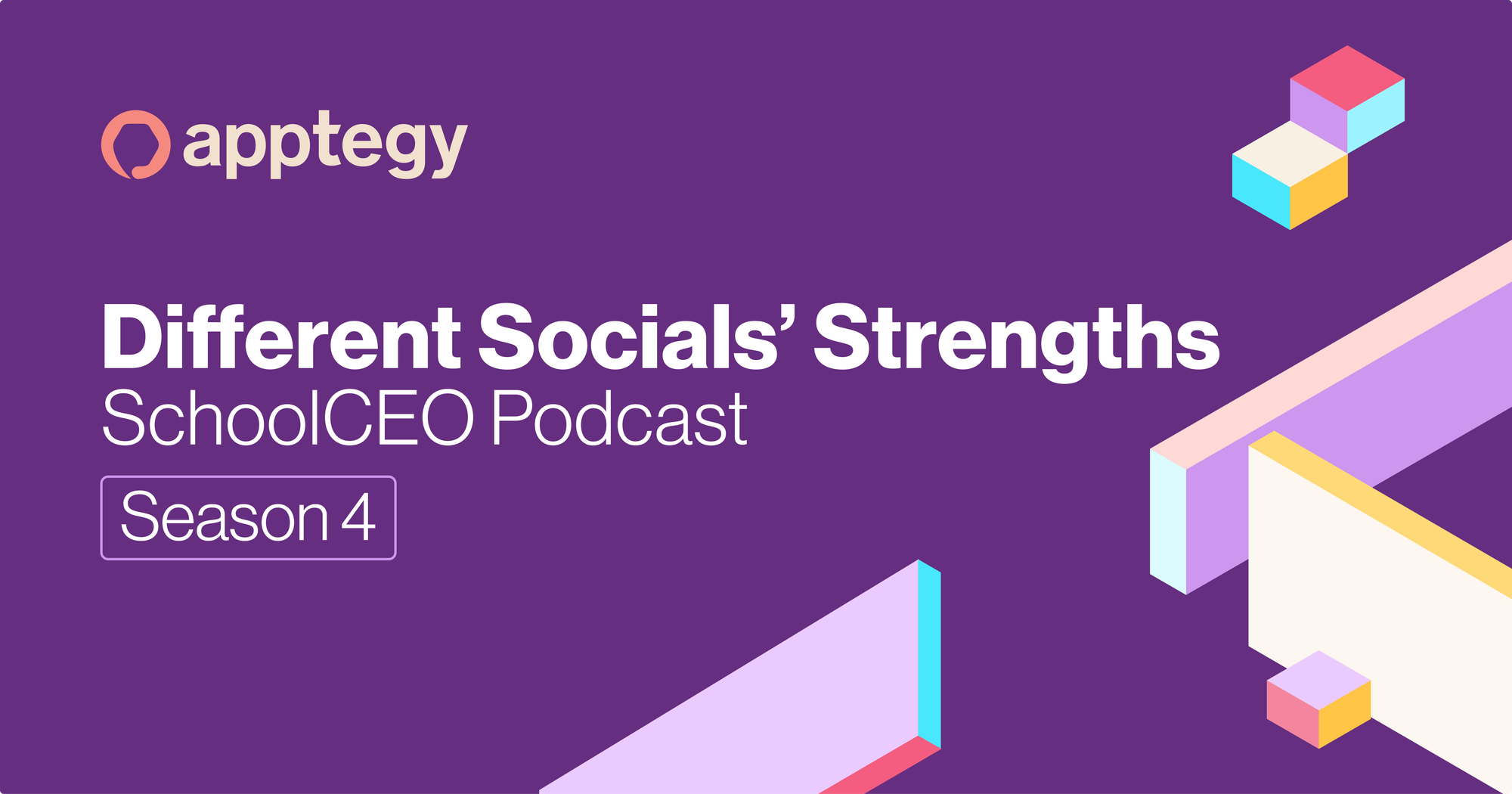Different Socials' Strengths
Today we continue to discuss the best digital channels for your communication strategy, focusing on social media this time.

Show Notes:
Listen to Does Social Media Work for Schools? to hear more about social media’s role in school communications.
Subscribe to our newsletter at https://www.schoolceo.com/subscribe-now/.
Visit us at schoolceo.com and connect with SchoolCEO on LinkedIn or X/Twitter @school_ceo.
If you have a story you’d like to share with the SchoolCEO team, email us at eileen@schoolceo.com or schedule a call.
SchoolCEO is powered by Apptegy, the maker of the leading K-12 communications and brand management platform.
Episode Transcript
Welcome to the SchoolCEO Podcast. I’m your host, Eileen Beard. Let’s pick up where we left off last episode and talk about where some of the most popular social media channels might fit into your strategic communication plan. Here’s a quick breakdown of each channel’s strengths:
Facebook is usually more popular with older parents and community members—making it an effective channel if your goals include building community engagement in support of a bond initiative, for example. It’s a great place to announce events and share photos. It also gives you some flexibility in that you can post both short and long form content. One big downside is that it can breed negativity and misinformation but that’s a downside most social media platforms share.
Instagram, on the other hand, is better for engaging younger parents and students. It’s a great platform for highlighting the kinds of achievements that can’t necessarily be measured—visual stories of happy students and happy staff. It works for planned content and capturing off-the-cuff moments. But like Facebook, the downside is that you can’t control the comments section.
Twitter is all about speed and brevity and it tends to be used more by older parents. It’s best for real-time updates like inclement weather announcements, but it's a hotbed of misinformation and negativity so you may want to stear clear of posting anything more in-depth.
TikTok was once all about student-created and student-centered content. This is still the place to show off your school or district’s fun side and strengthen students’ connection to your brand. However, it is now deeply popular with some parents, especially moms, who have built a supportive community on the platform. So this could be an excellent space to feature moms and kids—as long as it's playful. Like all of the social mediums I’ve mentioned, though, you have no control over whether your intended audience actually sees your content or not. Their mysterious algorithms control that.
YouTube is best for long form video content—the kind that is too long for Instagram or TikTok such as a virtual school tour or board meeting recording. You can link to your YouTube videos on Facebook, for example, but make sure you set up your own page so it's archived. Beware, if you turn on comments you may receive some nasty ones.
Finally, there’s LinkedIn. I wouldn’t worry about connecting with your students or families there. However, it is a great place to build your reputation among your peers and perhaps future business partners. It is a nonnegotiable social media channel if you’re actively recruiting staff.
So let’s go back to the specific, measurable goal I cited as an example in the last episode: You want to increase parent attendance at school board meetings by 25%. Here’s an example of a possible approach starting with the communication channels you own and including social media, too.
Start with your website and app. You should already have an events calendar with your school board meetings on it. Create a dedicated school board section on your site as well where you can house agenda items and recordings of previous meetings—and make sure it’s easy to find.
Send all of this information via newsletter, too, explaining how school board decisions may affect parents’ children specifically. You can share very similar content on your podcast if you have one. Use text to send a reminder 24-48 hrs ahead of the meeting.
Now, what about social media? Well, parents don’t connect with their schools on LinkedIn, so you can skip it. Although TikTok has a strong mom contingent, it’s not a serious information-sharing platform. I would argue the same thing for Instagram—content here should be short and visual. And although Twitter is used by older parents, the site gets more and more contentious every day. Finaly, YouTube should house videos of previous meetings, but it’s not good for announcing upcoming ones.
I’d argue you may only need one social media channel, used strategically, to get closer to your goal: Facebook. Although false information and negativity are also a risk here, if getting more parents to your board meetings is a major goal, monitor these particular announcements closely for bad behavior.
This is a total hypothetical, but I think it demonstrates my point. If you do your research and set specific, measurable goals, you might find you’ve been over-relying on social media and start to use it more strategically to serve those goals. You may even be able to drop one or more channels completely.
To hear a little bit more about the myth of social media, click on the link in the show notes to listen to our Season 3 episode about it.
Thanks for joining me.

